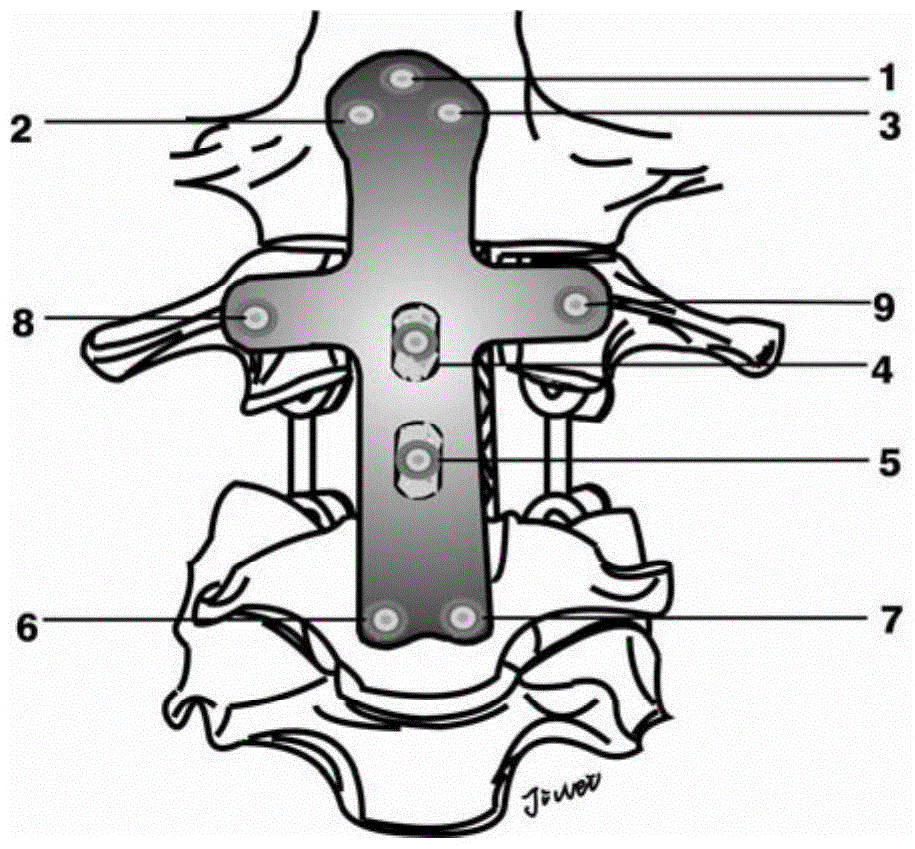Anterior cervical ramp fixation device
A technology of fixation devices and slopes, applied in the direction of fixators, internal fixators, internal bone synthesis, etc., to achieve the effect of good rehabilitation and good three-dimensional stability
- Summary
- Abstract
- Description
- Claims
- Application Information
AI Technical Summary
Problems solved by technology
Method used
Image
Examples
Embodiment 1
[0019] Embodiment 1: Preparation of the anterior cervical slope fixation device according to the present invention
[0020] Anterior cervical slope fixation device according to the present invention, such as figure 1 and figure 2 As shown, it includes: the main board, which is composed of a section of inclined main board slope fixing part 10 and a horizontal main board vertebral body fixing part 11; The mainboard slope fixing part 10 and the mainboard vertebral body fixing part 11 form a certain angle so that the mainboard slope fixing part is suitable to be close to the anterior slope of the human neck and the mainboard vertebral body fixing part is suitable to be close to the human cervical 3 vertebral body. Preferably, the angle between the slope fixing part 10 of the main board and the vertebral body fixing part 11 of the main board is 114° to 148°.
[0021] Such as figure 1 As shown, three screw holes 1, 2 and 3 are evenly arranged on the mainboard slope fixing part 1...
Embodiment 2
[0028] Embodiment 2: Application of the anterior cervical slope fixation device according to the present invention
[0029] The following is an embodiment of using the anterior cervical slope fixation device according to the present invention for clinical application.
[0030] Such as image 3 , 4 As shown in the figure, the patient with upper cervical spondylosis was lying supine on the operating bed. After successful anesthesia, the skin in the surgical field of the neck was disinfected, and sterile towels and drapes were spread.
[0031] Take the anterior and retropharyngeal approach of the upper cervical spine, expose the cervical vertebral body, perform fluoroscopy positioning, resect the C1 anterior arch and C2 vertebral body, perform C2-3 intervertebral discectomy, and choose a suitable titanium cage (Johnson & Johnson) to shape the head end firmly Attached to the edge of the slope, the tail end is fixed to the C3 endplate. Filled with bone fragments, the overhanging...
Embodiment 3
[0033] Example 3: Biomechanical Evaluation of the Stability of the Anterior Cervical Ramp Fixation Device
[0034] Purpose
[0035] From the perspective of biomechanics, discuss the stability of the invention patent for upper cervical spine fixation.
[0036] Experimental Materials
[0037] Slope plate titanium cage Kirschner wire bone screws Six fresh cadaveric head and neck specimens (vertebral bodies from C0 to C4 in the occipital condyle, 4 males, 2 females; mean age, 46 years; range, 35–62 years).
[0038] experimental method
[0039] 2.1 Specimen processing
[0040] The muscle tissue of the specimen was excised, and the bone and ligament structure was preserved. All specimens were stored in sealed double-layer plastic bags and stored in a -20° freezer. Before the experiment, the specimens were thawed at room temperature. General examination and front and side X-ray films to check whether the specimens are deformed, and dual-energy ray absorptiometry to check whether th...
PUM
 Login to View More
Login to View More Abstract
Description
Claims
Application Information
 Login to View More
Login to View More - R&D
- Intellectual Property
- Life Sciences
- Materials
- Tech Scout
- Unparalleled Data Quality
- Higher Quality Content
- 60% Fewer Hallucinations
Browse by: Latest US Patents, China's latest patents, Technical Efficacy Thesaurus, Application Domain, Technology Topic, Popular Technical Reports.
© 2025 PatSnap. All rights reserved.Legal|Privacy policy|Modern Slavery Act Transparency Statement|Sitemap|About US| Contact US: help@patsnap.com



